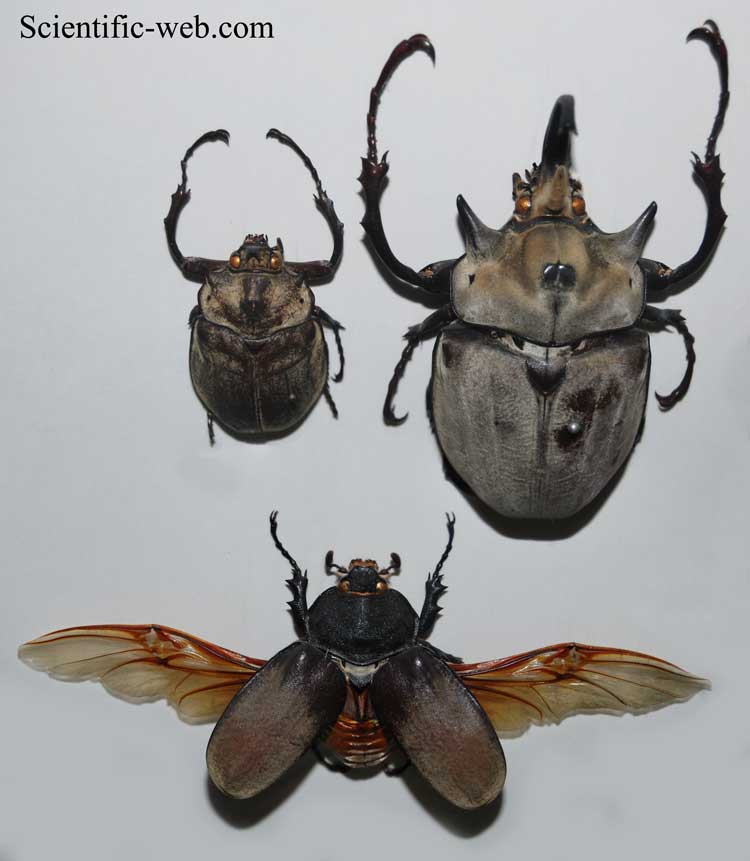
Megasoma elephas , Photo: Michael Lahanas
Superregnum: Eukaryota
Cladus: Unikonta
Cladus: Opisthokonta
Cladus: Holozoa
Regnum: Animalia
Subregnum: Eumetazoa
Cladus: Bilateria
Cladus: Nephrozoa
Cladus: Protostomia
Cladus: Ecdysozoa
Cladus: Panarthropoda
Phylum: Arthropoda
Subphylum: Hexapoda
Classis: Insecta
Cladus: Dicondylia
Subclassis: Pterygota
Cladus: Metapterygota
Infraclassis: Neoptera
Cladus: Eumetabola
Cladus: Endopterygota
Superordo: Coleopterida
Ordo: Coleoptera
Subordo: Polyphaga
Infraordo: Scarabaeiformia
Superfamilia: Scarabaeoidea
Familia: Scarabaeidae
Subfamilia: Dynastinae
Tribus: Dynastini
Genus: Megasoma
Species: Megasoma elephas
Subspecies: M. e. elephas – M. e. iijimai – M. e. occidentalis
Name
Megasoma elephas Fabricius 1775
Synonyms
Scarabaeus elephas Fabricius 1775
Megasoma mexicanum Fischer 1968
Megasoma elephas iijimai Nagai 2003
References
Krajcik, M. 2009. New species of Megasoma Kirby from Bolivia (Coleoptera, Scarabaeidae: Dynastinae). animma.x 29: 1–12. full article (PDF). Reference page. [see fig. 1]
Generic guide to new world scarab beetles
Vernacular names
magyar: Elefántbogár
The elephant beetle (Megasoma elephas) is a member of the family Scarabaeidae and the subfamily Dynastinae. They are Neotropical rhinoceros beetles.
Appearance
Male and female of Megasoma elephas at the Montreal Insectarium
Elephant beetles are black in color and covered with a coat of fine microscopic hairs. The hairs grow particularly thick on the beetle's elytra. The hairs give the beetle's body a yellowish color. Males have two horns protruding from the head and another from the prothorax. Females have no horns. The horns are used for defense, and in competition among males for food and mates.
Size
In size, elephant beetles range between 7 and 12 cm (2.75–4.75 in); males are sometimes even bigger. Males are around 2 to 3 times bigger than the females.
Location
Elephant beetles are located in southern Mexico, Central America, and in South American rainforests.[1]
List of subspecies
Megasoma elephas elephas (Fabricius, 1775)
Megasoma elephas iijimai Nagai, 2003
Breeding
Female Megasoma elephas in Costa Rica
Elephant beetle larvae develop in large decaying logs and take up to three years to develop into adult beetles, depending upon the subspecies. The female elephant beetle lays her eggs inside the decaying log or in the ground. Some weeks after that (usually three) the eggs hatch into C-shaped larvae, white grubs with brown heads and six legs. The larval stage lasts around 29 months, during which time the grubs consume organic matter. The third and last stage, the pupal stage, lasts around five weeks at a temperature of 26 degrees Celsius. The life span of an adult elephant beetle is around one to three months.
Food
For their diet, elephant beetles eat the sap of particular trees and ripened fallen fruits. In captivity, they also eat exotic fruits such as pineapples, longan, lychee fruit, and bark from certain trees like the poinciana.
Behavior and habitat
Elephant beetles live in rainforests and are mainly active during the night. They are able to maintain a high internal body heat when foraging despite reduced ambient temperature.[2]
Elephant beetle population has been depleted by the destruction of the rainforests, which has reduced their grounds for mating. In some countries such as Costa Rica, Nicaragua, and others in Central America the male's head is used as a charm necklace, decorated with gold. This has affected the population severely.
Potential military use
As part of a Pentagon-sponsored project, researchers at the University of California, Berkeley have implanted electrodes into elephant beetle pupae. This allows some remote control of the adults flying behaviour.[3]
See also
List of largest insects
References
http://www.discoverlife.org/mp/20m?kind=Megasoma+elephas
Temperature Regulation, Energy Metabolism and Mate-Searching in Rain Beetles
"Remote controlled bugs buzz off". BBC News. 2009-10-13. Retrieved 2009-10-14.
Retrieved from "http://en.wikipedia.org/"
All text is available under the terms of the GNU Free Documentation License

